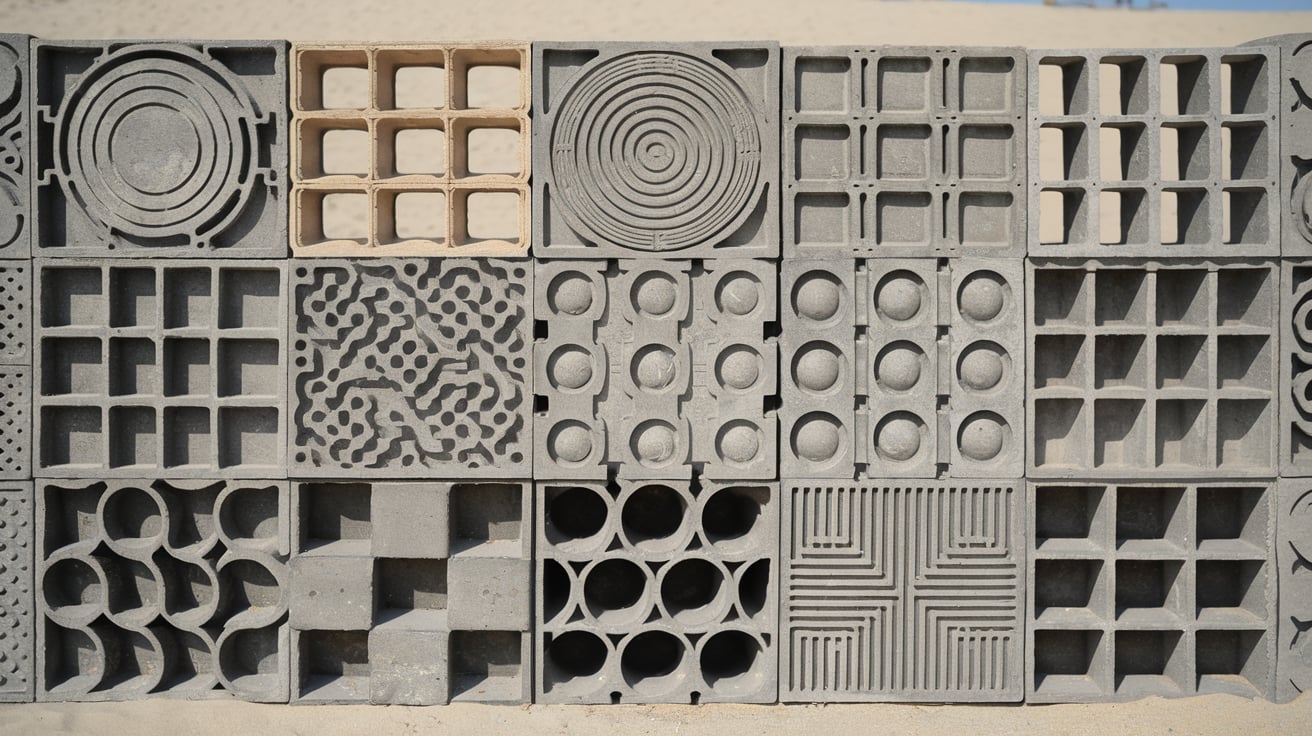Would you be willing to add character to your outdoor space?
A plain garden wall just doesn’t cut it anymore. Standard walls lack the personality that modern outdoor spaces need.
I’ll share a practical solution that combines beauty with function: breeze block walls. These concrete blocks can convert any basic wall into an eye-catching feature that lets light and air flow naturally through your space.
In this blog, I’ll walk you through breeze block wall ideas that work for any budget and style. You’ll find options that match your home’s personality while adding value to your outdoor living area.
What Are Breeze Block Walls?
Breeze block walls are made from hollow concrete blocks that feature open patterns or designs. These blocks, also called concrete masonry units, create walls that allow air and light to pass through while still providing structure and privacy.
The blocks come in many different shapes and sizes. You can find square patterns, circular holes, diamond shapes, and other geometric designs. Each pattern creates a unique look and feel for your outdoor space.
Originally popular in mid-century modern homes, breeze blocks are making a comeback in today’s designs. They work well for garden walls, privacy screens, and decorative features. The hollow design eases ventilation, while the concrete material provides strength and durability.
These breeze block wall ideas are perfect for homeowners who want something more interesting than a solid wall but still need privacy and structure.
Why Consider Breeze Block Walls?
Breeze block walls offer several practical benefits, making them a smart choice for any outdoor space. These walls provide excellent ventilation while still giving you privacy from neighbors.
The open design allows air to flow freely, which helps keep your patio or garden cooler during hot summer days.
From a cost perspective, breeze blocks are much more affordable than traditional brick or stone walls. You can install them yourself with basic tools, saving money on labor costs. They also require very little maintenance once installed.
The style factor is another significant advantage. Breeze block wall ideas create interesting shadow patterns throughout the day as sunlight filters through the openings. This adds visual interest to your space without blocking natural light completely.
The 13 Unique Breeze Block Wall Designs
1. Geometric Pattern Wall
Simple shapes combine to create striking visual effects. Arranging blocks in chevron patterns draws the eye upward, while diamond formations add depth.
Hexagonal patterns offer a modern touch that works well in contemporary settings.
2. Color Block Wall
Paint transforms ordinary concrete into statement pieces. Try soft pastels for a gentle look or bold colors for visual impact.
Some homeowners opt for a single shade, while others create gradients or color blocks. Weather-resistant concrete paint ensures lasting beauty.
3. Mosaic Breeze Block Wall
Mix different block styles to create one-of-a-kind designs. Combine various openings and patterns for added interest. This style works particularly well for large walls where repetitive patterns might feel overwhelming.
Consider using blocks with circular, square, and diamond openings together.
4. Vertical Garden Wall
Turn wall openings into mini planters for herbs or succulents. The holes provide perfect spots for small potted plants. For easy maintenance, add irrigation systems through the openings.
This design merges structure with nature, creating living art that changes with the seasons.
5. Outdoor Fireplace Wall
You can create a cozy outdoor room with a breeze-block backdrop for your fire pit. The blocks’ natural heat resistance makes them ideal for this purpose.
Design the wall to include wood storage spaces or decorative niches. Consider how the firelight will play through the openings at night.
6. Water Feature Wall
Incorporate water into breeze block walls to add movement and sound to your outdoor space. The blocks’ natural openings create perfect channels for water to flow.
The trickling effect catches light and creates soothing sounds, ideal for meditation spaces or entertainment areas.
Install proper lighting to create magical evening effects as water glimmers through the openings. Add small pooling areas at the base to complete the sensory experience.
7. Tiered Retaining Wall
Using breeze blocks, you can build attractive solutions for sloped yards. These structured walls hold soil while creating usable garden spaces.
Each tier can serve different purposes – flower beds, herb gardens, or seating areas.
The blocks’ pattern adds visual interest to what would typically be plain retaining walls. Consider mixing heights and depths to create more dynamic spaces.
8. Privacy Screen Wall
Create separation without completely closing off spaces. These walls filter views while maintaining natural airflow and light. Perfect for pool areas, patios, or outdoor showers.
The filtered light creates interesting shadow patterns throughout the day.
Position blocks strategically to maximize privacy where needed while keeping open sight lines in other areas.
9. Breeze Block Garden Border
Define garden spaces with low-height decorative borders. These borders keep mulch and soil contained while adding architectural detail.
The openings allow excess water to drain naturally. Perfect for creating clean lines between lawn and garden areas.
Consider alternating block patterns to create rhythm along garden edges.
10. Breeze Block Planter Wall
Turn your wall into a vertical growing space. Each opening becomes a pocket for plants, creating living walls of greenery. This method is ideal for small gardens with limited ground space.
Select plants that cascade or grow upright depending on the desired effect. Consider:
- Drought-resistant plants for low-maintenance
- Flowering varieties for seasonal color
- Herbs for kitchen gardens
- Succulents for minimal care
11. Breeze Block Bench Wall
Create functional seating that doubles as a boundary marker. To create comfortable resting spots, top the block walls with smooth concrete or wooden seats.
Add cushions for color and comfort. Build a standard seating height (18-20 inches) for ergonomic use. Include:
- Back support sections
- Side tables within the design
- Storage spaces underneath
- Lighting for evening use
12. Indoor Accent Wall
Bring breeze blocks inside to create distinctive room dividers or feature walls.
They work particularly well in:
- Sunrooms
- Bathrooms
- Living areas
- Home offices: Natural light filtering creates interesting interior effects while maintaining airflow between spaces. Consider painting interior blocks to match your color scheme.
13. Mixed-Material Breeze Block Wall
Combine blocks with other materials to create distinctive designs:
- Insert metal panels for a modern contrast
- Add glass blocks for extra light
- Include wooden sections for warmth
- Use stone accents for texture
Maintaining Your Breeze Block Wall
Keeping your breeze block wall ideas looking great doesn’t have to be complicated. With regular care and attention, these walls can last for decades while maintaining their good looks and functionality.
1. Regular Cleaning
Clean your breeze block wall twice a year using mild soap and water.
A soft brush helps remove dust and debris from the openings. Avoid high-pressure washing, as it might damage the blocks or mortar.
You can use a specialized concrete cleaner for stubborn stains, but test it on a small area first.
2. Structural Checks
Please look at each spring of your wall for any loose blocks or cracking mortar.
Look for signs of movement or settling, especially after winter.
Check the foundation area for proper drainage and ensure water isn’t pooling around the base. Small cracks should be addressed quickly to prevent bigger issues.
3. Drainage Maintenance
Please remove leaves, dirt, and plant material from the wall’s openings. Good airflow and drainage prevent moisture buildup that could damage the blocks.
You should pay special attention to ground-level openings where debris tends to collect.
Remove any climbing plant roots that might be growing into the mortar joints.
4. Paint and Sealant Care
If your wall is painted, look for peeling or fading spots annually. Touch up as needed using appropriate exterior concrete paint.
For sealed walls, reapply the sealant every 3-5 years to maintain protection against moisture and weather damage. Choose clear sealants that allow the blocks to breathe.
5. Plant Management
For walls with integrated plants, trim back overgrowth regularly. Remove dead plants and replace the soil in planting pockets as needed. Check that plant roots aren’t causing structural issues.
Please ensure irrigation systems work properly and not create wet spots on the wall.
6. Winter Preparation
In cold climates, check that drainage holes are clear before winter.
Remove any standing water sources near the wall. Consider using breathable covers for sensitive plants in wall planters during severe weather.
7. Long-term Care
Document any repairs or changes to your wall. Keep records of paint colors and sealant types used.
You can build relationships with local contractors who understand breeze block construction plans for periodic professional inspections, especially for complex designs or older walls.
Conclusion
Building a breeze block wall offers more than boundary marking; it’s about creating spaces that reflect your style while serving practical purposes.
These breeze block wall ideas can convert any outdoor area into something special. The beauty lies in their dual nature: they provide privacy while allowing light and air to flow naturally. These walls create structure while adding visual interest, and offer strength while maintaining a light appearance.
Proper planning and maintenance will keep your wall looking fresh and performing well for years. Your outdoor space is worth this thoughtful addition.





















